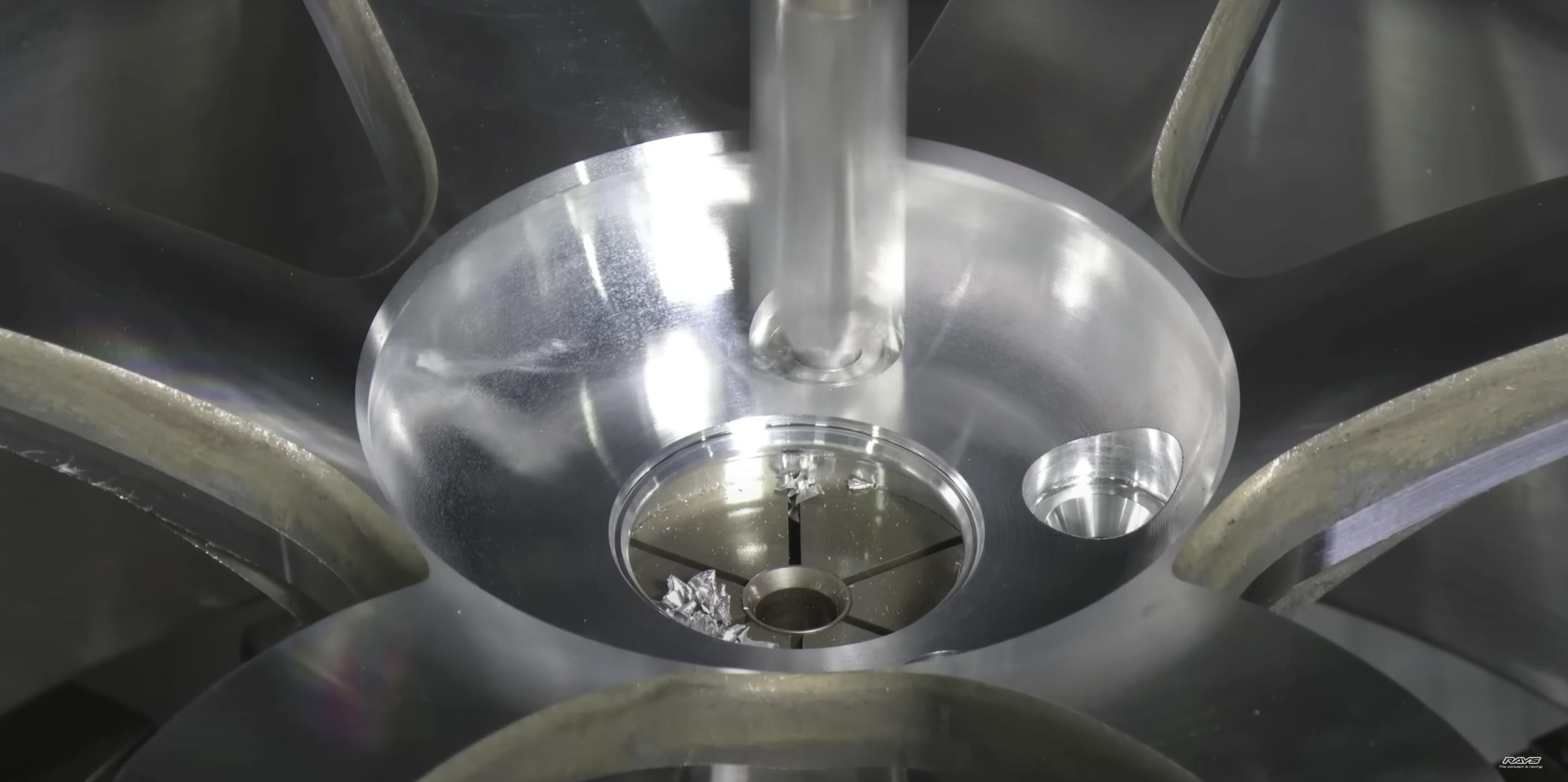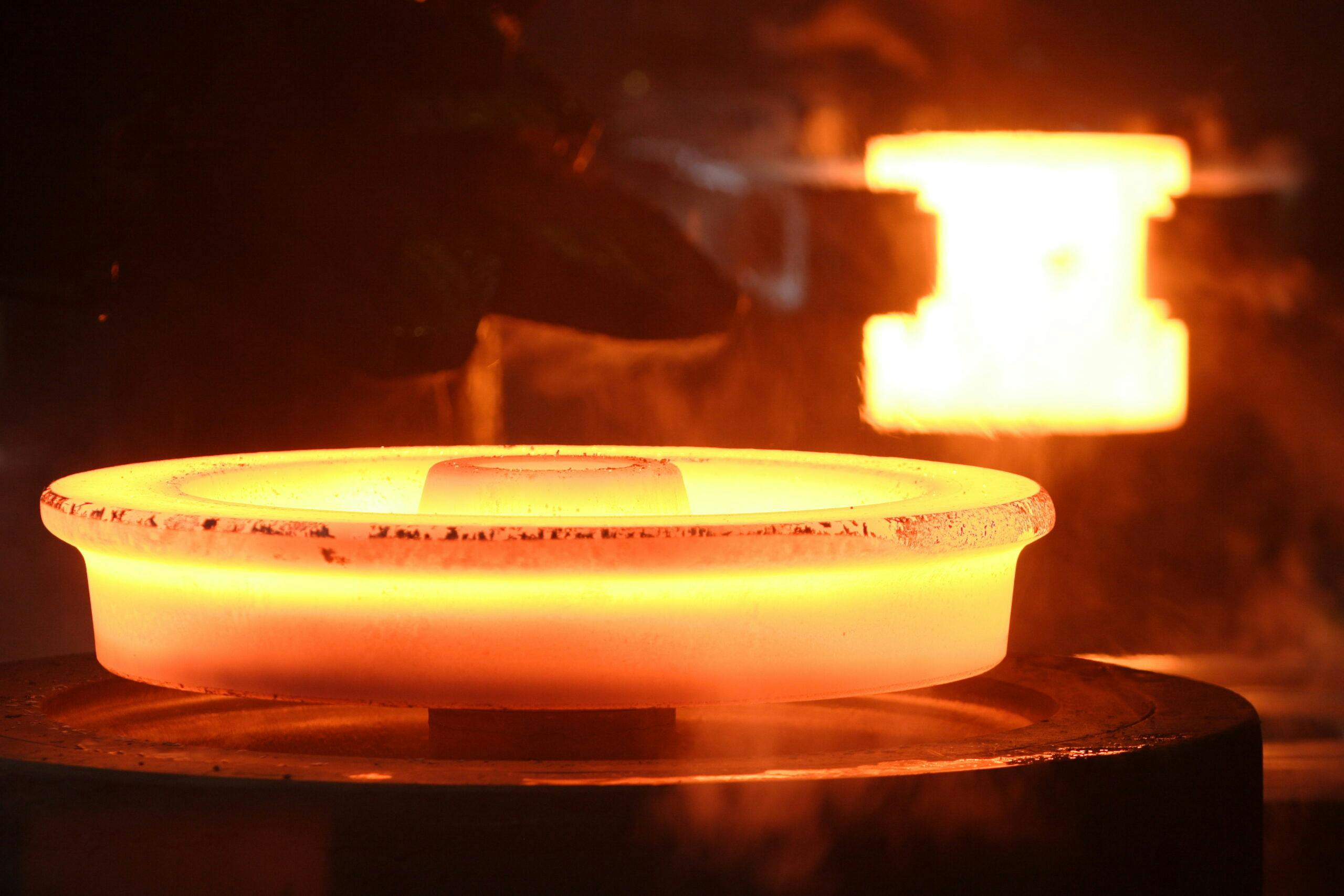Media | Articles
How forged wheels are made

In the hall of famous wheels, alongside the Cragar SS and American Racing Torque Thrust, sits the Rays TE37. A lightweight, strong, and six-spoke design that has stood the test of time, the TE37 is one of if not the pioneering design in the forged-wheel world. How does Rays create it? Thanks to YouTube, we got an inside look.
To start, we need to define a few terms. First, cast wheels. These are constructed by pouring molten metal into a mold, leaving the material to cool, and then finish-machining it into ready-to-install form. Forged wheels use a similar process combined with nature’s time-proven method of creating great things: pressure and heat.
The initial three pressings of the raw material bring the face of the wheel into shape as a gigantic press applies several thousand tons of pressure. This incremental pressing refines the grain structure of the aluminum, making the end product stronger and less fragile than a cast wheel.

However simple the process may sounds, multiple points in this video confirm that Rays wants to keep some trade secrets, well, secret. There is a lot more to the exact process than just clamping some aluminum in a huge press—and we do mean huge.
A home shop press might be capable of producing ten tons of pressure; the one used to create TE37 wheels is capable of producing 10,000. That’s why, after only a few seconds, you can recognize that classic six-spoke design in what used to be a round chunk of slag.

Once that wheel face has been pressed into rough shape, the edges are rounded to make it safer to handle and to keep fractures or bends—known as stress risers—at bay. The final shape is so much more than meets the eye, even if it still doesn’t look like a wheel. That milestone is reached when a pair of rollers push what looks like excess aluminum down and around to create the barrel of the wheel.
From there, the wheel goes off to heat-treating and finish-machining. The first process hardens the wheel, and the second trues up the mountain faces and adds recesses for the lug nuts. After a little pop of color, the wheel heads to the tire shop for some rubber.
A lightweight forged wheel is still the gold standard, even as carbon-fiber wheels become increasingly popular. (You can find woven rims on dealer lots these days.) Forged aluminum has strength and durability of which a carbon-fiber wheel could only dream: If you drive pot-holed streets or take a little too much curb during on-track excursions, we can probably guess what your wheels are made of. A wise choice, and now you know exactly how your wheels went from raw aluminum to race-ready.
***
Marketplace
Buy and sell classics with confidence
Check out the Hagerty Media homepage so you don’t miss a single story, or better yet, bookmark it. To get our best stories delivered right to your inbox, subscribe to our newsletters.








The TE37 is great, but really: “the TE37 is one of if not the pioneering design in the forged-wheel world”?
The TE37 came out in 1996. The archetypal forged Fuchs wheel came out for the 911S in 1966. Pretty sure it lays any claim to being the pioneering design of forged wheels.
I think the BBS lace wheels of the 80’s is where things really changed. Better forging and the use of three piece wheels made it so you can change a wheel width or offset and repair them easily.
Centerline brought us the affordable forged wheel.
Even the Forge wheels that came on my 02 Corvette have held up well and are well made.
Many people really have no clue what a good wheel is and how much they cost. I still see guys complain over the Cragar SS wheels costing near $200 or a cheap chrome wheel that sells for $60 rusting. You get what you pay for.
I would take either the Fuchs or the BBS lace wheels over these any day. These are just not good looking wheels.
I am assuming that you’re a European car enthusiast. On a BMW, AMG Mercedes, I would agree, the TE37 would look really bad. Japanese cars however… DAYUM. The TE37 looks incredible, but with the exception of a Subaru, BBS would not look good.
Agreed. The wheels have to match the vehicle. Modern wheels on vintage cars are especially tricky to pull off.
When 3 spoke wheels were the rage (for a while in the ’90s, but fortunately that went away) I friend got one for his Honda Civic coupe. On that particular car the curves of the spokes matched up nicely to the rear pillar and the wheels looked great on it. On every other car I’ve seen them on they looked out of place.
The TE37 is the big daddy of forged wheels for Japanese cars. They look good on everything sporty, NSX, GT-R, Supra, RX-7, Z car, etc. I normally would prefer a 5 spoke wheel or a 7, etc. but this 6 spoke design is great.
Why the picture of a train wheel?
Maybe to illustrate something closer to “…pioneering design in the forged-wheel world” 😉
back in the early 70’s I had a Fiat 128SL with Campagnolo rims that really made the car.
Really it’s the Japanese wheel brands like Volk/Rays and Work that lead the manufacturing process. For Nissan, Lexus Toyota or Honda/Acura performance machines there are no substitutes.
Work pioneered the process of the multi-piece forged lightweight wheel along with Volk/Rays. The designs really don’t suit European high performance cars or most American cars at all.
Halibrand?????
I see that nobody already expressed my reaction to this story. The Fuchs forged aluminum wheel was standard on the 1967 Porsche 911S, and became common on all subsequent 911s through 1989. They are still available. Fuchs had to develop new manufacturing techniques to make this wheel. In his 1981 book, “How to Make Your Car Handle,” Fred Puhn said, of the Fuchs wheels: “They are nearly as light as the lightest racing wheels and are strong enough for unlimited street use. These are probably the best all-around wheels you can buy . . “
Just can’t get behind that style….NOW,make it look like a Panasport (Minilites) and I’d buy them ✌️
Despite its being a blatant advertisement for Rays Wheels, this is a remarkably informative video. Worth watching. Remember that the product itself and the manufacturer’s propaganda are two separate things.
Oh, for a brief moment I thought they may have been made in America. Should have known better.
I remember an R&T Ampersand comment (probably Peter Egan) about an ad for an early Datsun 240Z with “rare original steel wheels”.
The author called the aluminum billets “slag”. Slag is impurities removed during the smelting process.